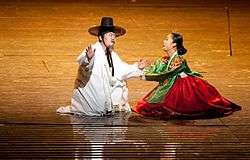Simcheongga
| Simcheongga | |
| Hangul | 심청가 |
|---|---|
| Hanja | 沈淸歌 |
| Revised Romanization | simcheongga |
| McCune–Reischauer | simch'ŏngga |
Simcheongga is one of the five surviving stories of the Korean pansori storytelling tradition. The other stories are Chunhyangga, Heungbuga, Jeokbyeokga, and Sugungga.
History

The exact date of when Simcheong story was adapted into a panosori is unknown. According to records, Simcheongga can be found in the Gwanuhui written by Manjae Song in the time of Sunjo of Joseon, and also in The History of Joseon Traditional Opera written by Nosik Hung in the 1900s.
Simcheongga is considered to have been made a great piece of art through the contribution of pansori singers' deoneum.
Simcheongga is the most tragic of the five pansoris. The story is almost wholly one of grief and sadness. Therefore, the melody sounds low and gloomy as well. In pansori, the feeling of the voice is more important than its purity or beauty: a beautiful voice can't express the joy and grief of living. To express deep sorrow, the pansori requires "a voice like geuneul (shadows)." In Simcheongga, the mystic geneul is important, so only a master singer of pansori is considered to possess the ability to perform Simcheongga well.
Story
There are five parts in Simcheongga.
Simcheongga is about Simcheong and her father, Sim Hak-Gyu, whom people call Sim-Bongsa (Sim the Blind). She has to take care of her blind father. The sad story is occasionally lightened with humor.
The highlight of this pansori is when Sim-Bongsa regains his eyesight. A realistic expression of this requires a master singer of pansori. After Sim-Bongsa regains his eyesight, other blind people also recover. Finally, Simcheongga ends in a festive mood.[1]
See also
References
- ↑ 재미있는 우리국악 이야기,서해문집